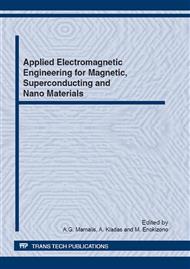p.27
p.33
p.41
p.47
p.53
p.59
p.65
p.71
p.79
Fe-Mn-Si/6.5wt%Si-Fe Bilayer Ribbons produced by Using Melt Spinning Technique
Abstract:
Recently, progress of the intelligent materials plays a big role in development of science and technology. We have ever tried to develop ferromagnetic shape memory alloys to expand application range of the common non-magnetic shape memory alloys, which are typical intelligent material. However the saturation magnetization and the shape memory effect were in a relation of trade-off, so we couldn’t get a good result. In this research, we tried to develop ferromagnetic shape-memory alloys as a composite material by using the single-roll melt spinning technique. They are bilayer ribbons, which have both shape memory layer and magnetic layer.
Info:
Periodical:
Pages:
53-58
Citation:
Online since:
June 2012
Authors:
Price:
Сopyright:
© 2012 Trans Tech Publications Ltd. All Rights Reserved
Share:
Citation:


